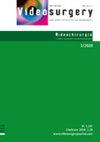肾细胞癌经皮冷冻消融后腹壁假性疝的危险因素
IF 1.6
4区 医学
Q2 SURGERY
引用次数: 1
摘要
经皮冷冻消融(PCA)越来越被认为是一种可行的微创、保留肾细胞的治疗肾细胞癌的方法,其疗效与肾切除术相当。腹壁假性疝(AWP)是PCA治疗肾包块的罕见并发症,它会对患者的生活质量产生负面影响。目的回顾性评价前列腺癌后AWP的危险因素及预后,并在此基础上探讨降低图像引导下前列腺癌治疗肾包块后AWP风险的策略。材料和方法我们回顾性研究了2016年至2019年在我院92例患者中进行的117例肾脏肿块的PCAs。我们比较了发生AWP和未发生AWP的患者的以下临床特征(年龄、性别、体重指数、肿瘤直径、肾肾测量评分、手术细节、经导管动脉栓塞、解剖技术、使用的冷冻针数量、针的位置和冰球的位置)。结果在我们研究组的117例(92例)pca中,有6例(5.1%)出现了AWP并发症。经直立棘肌穿刺(p < 0.01)和未使用水或气分离(p = 0.01)被确定为AWP的危险因素。结论:尽管PCA相对安全,且相关AWP的发生是一种罕见且罕见的并发症,但通过避免刺穿直立棘肌和使用水或气分离可以进一步降低AWP的风险。本文章由计算机程序翻译,如有差异,请以英文原文为准。
Risk factors for abdominal wall pseudohernia after percutaneous cryoablation of renal cell carcinoma
Introduction Percutaneous cryoablation (PCA) is increasingly recognized as a feasible minimally invasive, nephron-sparing treatment for renal cell carcinomas, with comparable efficacy to nephrectomy. The development of abdominal wall pseudohernia (AWP) is a rare complication of PCA for renal masses, which can negatively impact patients’ quality of life. Aim To retrospectively evaluate the risk factors and prognosis for AWP after PCA and, based on these results, to discuss strategies to lower the risk of AWP associated with image-guided PCA for renal masses. Material and methods We retrospectively studied 117 PCAs performed for renal masses in 92 patients, between 2016 and 2019, at our hospital. We compared the following clinical characteristics (age, sex, body mass index, tumour diameter, RENAL nephrometry score, procedural details, transcatheter arterial embolization, dissection techniques, number of cryoneedles used, location of needles, and location of ice ball) between those who developed AWP and those who did not. Results Of the 117 PCAs (92 patients) included in our study group, AWP complications were observed in 6 (5.1%) procedures. Puncture through the erector spinae muscle (p < 0.01) and non-use of hydro- or pneumo-dissection (p = 0.01) were identified as risk factors for AWP. Conclusions Although PCA is relatively safe to perform and the occurrence of an associated AWP is a rare and infrequent complication, the risk for AWP could be further decreased by avoiding punctures through the erector spinae muscle and using hydro- or pneumo-dissection.
求助全文
通过发布文献求助,成功后即可免费获取论文全文。
去求助
来源期刊
CiteScore
2.80
自引率
23.50%
发文量
48
审稿时长
12 weeks
期刊介绍:
Videosurgery and other miniinvasive techniques serves as a forum for exchange of multidisciplinary experiences in fields such as: surgery, gynaecology, urology, gastroenterology, neurosurgery, ENT surgery, cardiac surgery, anaesthesiology and radiology, as well as other branches of medicine dealing with miniinvasive techniques.

 求助内容:
求助内容: 应助结果提醒方式:
应助结果提醒方式:


